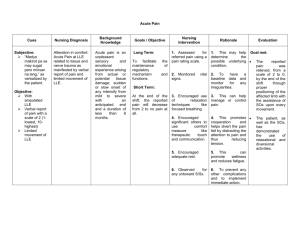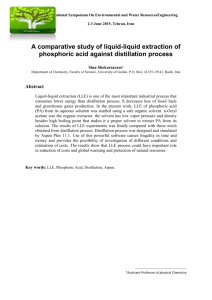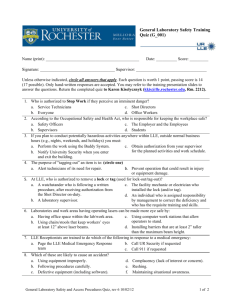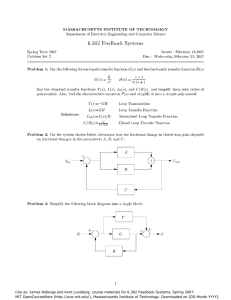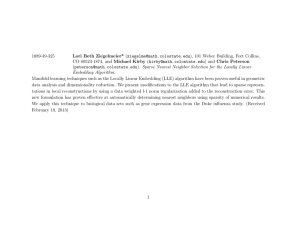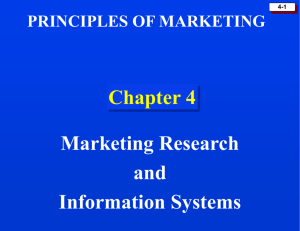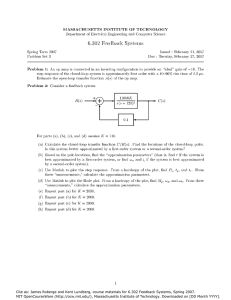MASSACHUSETTS INSTITUTE OF TECHNOLOGY Cornpllt,er Science Spring Terrr~
advertisement
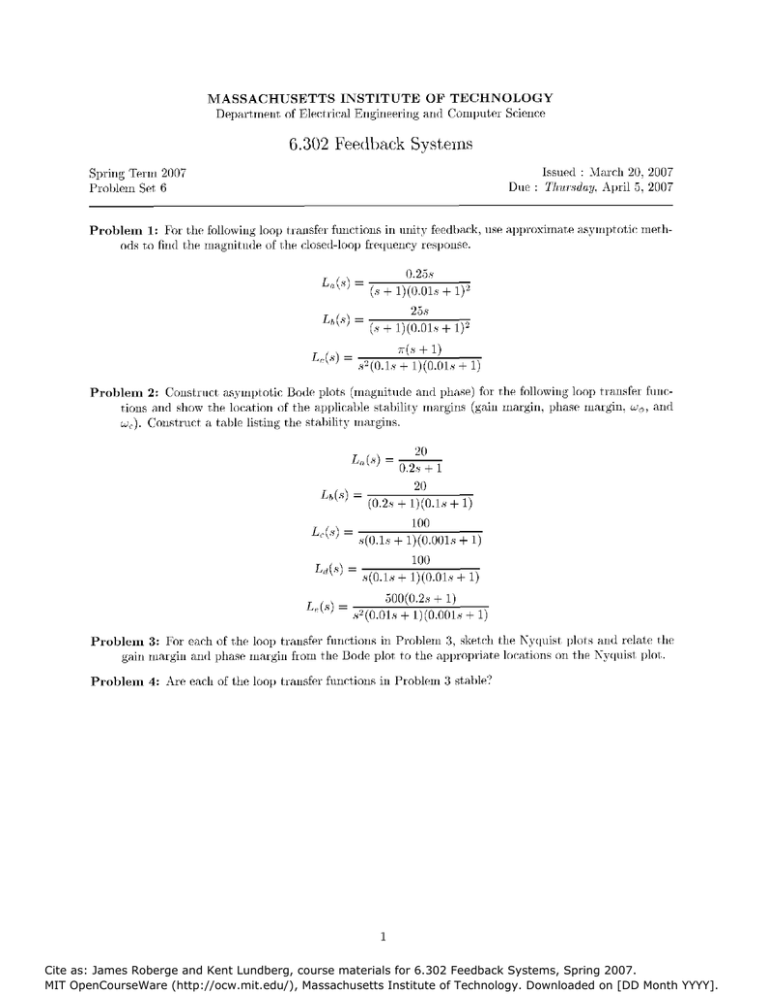
MASSACHUSETTS INSTITUTE OF TECHNOLOGY Depart,rnent of Electrical Engineering ar~rlCornpllt,er Science Spring Terrr~2007 Prol~lernSet 6 Problem 1: For t l ~ efolio\%-ing loop trar~sferfim<:tionsin unity fee(it)a<:k,use approximate asyrr~ptot,icrnetho(is to find t l ~ ernagnitil(ie of t l ~ ecloserl-loop freqllency response. Problem 2: Cor~stri~ct asyrnptot,ic Bode plots (rnagnit,ll(le ar~rlphase) for t l ~ efolio\%-ing loop trar~sferfilnctior~sand she\%- t l ~ elo<:ation of the app1icat)le stal)ility rr~argirls(gain rnargin. phase rnargin. d o , ar~rl w,). Const,nl<:ta tal~lelistir~gt l ~ estal~ilityrr~argins. Problem 3: For each of t l ~ eloop trar~sferfilr~ct,ior~s in Prol~lern3, sket,cl~the Kyql~istplots and relat,e t l ~ e gain rr~argir~ frorr~the Bode plot to the appropriate locat,ior~son t,lx Ky(ll~istplot. ar~rlphase rr~argir~ Problem 4: .ire each of t,lx loop trar~sferfilr~ct,ior~s in Prot)lerr~3 st,at)le'! Cite as: James Roberge and Kent Lundberg, course materials for 6.302 Feedback Systems, Spring 2007. MIT OpenCourseWare (http://ocw.mit.edu/), Massachusetts Institute of Technology. Downloaded on [DD Month YYYY]. Problem 5: Y ~ Iare I giver1 a. set of performance specifi<:ationsfor a i~nit,y-gainfee(it)a<:ksystem. They are as folio\%-s: Crossover fre(l~lencyof d,: = 100 111s rritl~a slope of -1 at c:rossover Zero stearly strxte error for a ramp i n p ~ ~ t , . 1% < 0.00S for simlsoiclal i n p ~ ~over t s t,lle range 0 < w < 1 rps For sensor rloise varirxtions in t,lle fre(l11e11~:y range d > 1000 rps, 1 1< 0.1. To o1)tain an a(ircluat,e rrlargir~of st,at)ility. t l ~ efre(l~len<:y rarlge of t l ~ e-1 slope arolln(i (:rossover sl~ol~lrl l)e at least 2 (iec:a(ies. The phase rrlargir~sl~ol~lrl l ~ ea t least 60". (a) Drrx~vt l ~ eDorle o1)stacle course for tllese s~~ecificat,ions. (I)) Corlstr~~ct an asyrnpt,oti<:Dorle rnagnitnrle curve m11i~:hmill rrleet tllese specifi<:ationswith as litt,le extra rrlagr~it~lrle as possil)le. At t l ~ e<:ornersof your (iiagrarn lal~elt,lle corrler frr(l~len<:ies arlrl t l ~ e vrx111esnf t,lle irlag~~it,llcles nf L(jw) at each corner. Give an expression for a ratiorlal filr~ctior~ L(s) \%-hichwill exhil~itt,lle sarrle asyrnpt,otic curve thrxt yn11have just, <:or~st,rl~(:te(i. ( c ) Based 11pon the asyrr~ptot,icrnagnit~ldecurve of part (I]), rlraw t l ~ eapproxirr~at,easyrnpt,ot,icDo& rnagnit~ldecurve of t l ~ ecloser1 loop response I;&) . I I Problem 6: For t l ~ efolio\%-ing feecll~acksysterrl arlrl plant trarlsfer fim<:tionGI (s) (a) Corlstr~~ct a. Bncle ot)st,acle <:ollrseillat rrleets the folln\%-i~~g s~~ecificat,ions: For the t,irrle t,o t,lle first 11eakto l)e less tllar~0.085 se<:onrl,d rnagnit~ldecrossover o<:cllrat 40 rps. d > 37 rps. !Ye earl t1111srequire that < For t,lle peak oversl~oott o l)e less t , l ~ a 30%,, r~ = 0.36 or Al, = 1.5. (verify illis fact) For an error of less t , l ~ a 0.0023 r~ rarliar~sfor a. velocity i n p ~ of ~ t1 111s. the rrlagnit,llcleof L(s) at lo\%freclllencies rrlllst t)ehrxve at least as m. d (I)) Clloose an asyrnpt,oti<:representation for t l ~ eDo& rrlagr~it~lrle response of L ( j d ) ancl cleterrr~inea corr~pensationfilr~ctior~ G,,(s) rrl~icl~ mill erlsllre t,llat t,lle closecl-loo11syst,ern rrleets all of t,lle sl~ecifications. ( c ) If high fre(l~lencyrloise is present at t l ~ eo~ltpl~t,. over what fre(l~len<:y rarlge will t,lle error rlue tn rloise Ile less tllar~1%)nf the rloise t)ase(ion your elloice of G,(.s)'! Cite as: James Roberge and Kent Lundberg, course materials for 6.302 Feedback Systems, Spring 2007. MIT OpenCourseWare (http://ocw.mit.edu/), Massachusetts Institute of Technology. Downloaded on [DD Month YYYY].
